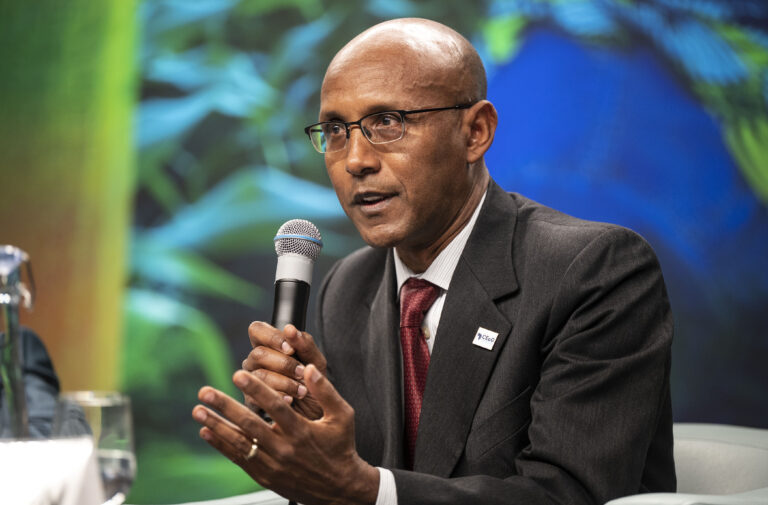
Land marked with gulleys in Kerio Valley, Elgeyo/Marakwet County. [PHOTO: KEVIN TUNOI).
By Daisy Okiring
June 5, 2025 — Nairobi, Kenya– As the world marks World Environment Day 2025, themed “Land Restoration, Desertification, and Drought Resilience,” Kenya finds itself at a crossroads. While agriculture remains the backbone of the economy—contributing about 33% to GDP and employing over 70% of the rural population (KNBS, 2023)—its future is imperiled by a crisis that lies just beneath our feet: soil degradation.
According to the Soil Atlas of Kenya 2025, only 20% of the country’s land remains arable, and up to 26 tons of soil per hectare are lost every year through erosion . In key agricultural zones—such as Embu, Meru, and Machakos—fields that once yielded bountiful crops are now dust-choked landscapes.
This crisis isn’t merely environmental; it’s existential. Without fertile soil, food systems collapse. And as desertification spreads, Kenya faces a perilous decline in food security, biodiversity, and rural livelihoods.
Voices of Alarm from Kenya and Beyond
Experts and environmental leaders have repeatedly sounded the alarm on soil degradation in Africa. Joachim Paul, Director of the Heinrich Böll Foundation in Kenya, warns:
“Soil is the foundation of life, yet it remains one of the most overlooked and undervalued resources.”
Dr. Harun Warui, Program Coordinator at the same organization, points to the necessity of agroecology:
“Agroecology offers a sustainable path forward by integrating biodiversity, soil management, and organic inputs.”
Also Read: Should Africa be compensated for a climate crisis it didn’t cause?
These insights echo the prescient words of the late Professor Wangari Maathai, founder of the Green Belt Movement and Nobel Peace Prize laureate, who once stated:
“If you don’t take care of this land today, tomorrow you will have rocks, not soil.”
Across Kenya, the evidence is clear. Approximately 63% of arable land is currently affected by acidity, 80% suffers from phosphorus deficiency, and 75% lacks sufficient organic carbon for healthy soil biology. These deficiencies are not simply technical—they represent a breakdown in the nation’s agricultural and ecological balance.

Once-productive farmland in Makueni County lies fallow, with visible signs of gully erosion after heavy rains stripped the topsoil. (Photo/UN).
Root Causes: Policies, Pressure, and Practices
Kenya’s soil crisis stems from a toxic mix of unsustainable farming practices, poor land-use planning, and population pressure. Monoculture farming—especially of maize and sugarcane—exhausts the land, while overuse of chemical fertilizers disrupts soil microbiomes. Furthermore, land fragmentation due to inheritance traditions has led to uneconomic, overworked plots with no space for rotation or fallowing.
The government’s policy priorities have often focused on increasing short-term yields and exports rather than promoting long-term ecological stewardship. The National Land Use Policy (2017), while well-intentioned, has seen sluggish implementation at the county level. Meanwhile, agricultural extension services remain underfunded and underutilized.
Also Read: Côte d’Ivoire & WorldFish launch West African Aquatic Food Hub
These systemic failures exacerbate the impacts of climate change, particularly in arid and semi-arid lands (ASALs) where rainfall is increasingly erratic. Flash floods in some seasons and prolonged droughts in others further degrade fragile soils, fueling rural poverty and migration.

A farmer in Murang’a County demonstrate intercropping techniques that restore nitrogen to depleted soils—an example of successful agroecology in action. (Photo/Famers Trend).
Pathways to Restoration and Resilience
While the picture is grim, the road to recovery is not only possible—it is already unfolding in parts of Kenya.
The Green Belt Movement, founded by Maathai, has planted over 51 million trees, restoring forests and improving watershed health. Trees act as natural barriers against erosion, and their roots help bind soil even during heavy rains.
One Acre Fund, another impactful organization, provides smallholder farmers with access to seed varieties, composting techniques, and soil-testing kits. Their model of direct extension support and micro-financing has increased farm yields by up to 250% in target counties.

A farmer in Kitui surveys his dry, cracked field after a failed maize harvest. Soil erosion and nutrient depletion are worsening in Kenya’s semi-arid regions. (Photo/MMP).
Internationally, Kenya is part of the TerrAfrica Partnership, a pan-African initiative under the African Union and supported by the World Bank, which funds land rehabilitation efforts across more than 20 African nations. Meanwhile, the United Nations Food and Agriculture Organization (FAO) works with communities near Mount Kenya to implement conservation agriculture and land restoration—techniques such as contour farming, composting, and minimal tillage that reduce erosion and improve carbon retention.
These programs show that regenerative agriculture, when rooted in local knowledge and supported by science, can be both economically viable and ecologically sustainable.




2 thoughts on “Kenya’s soil crisis is Africa’s warning to restore the earth”
Comments are closed.